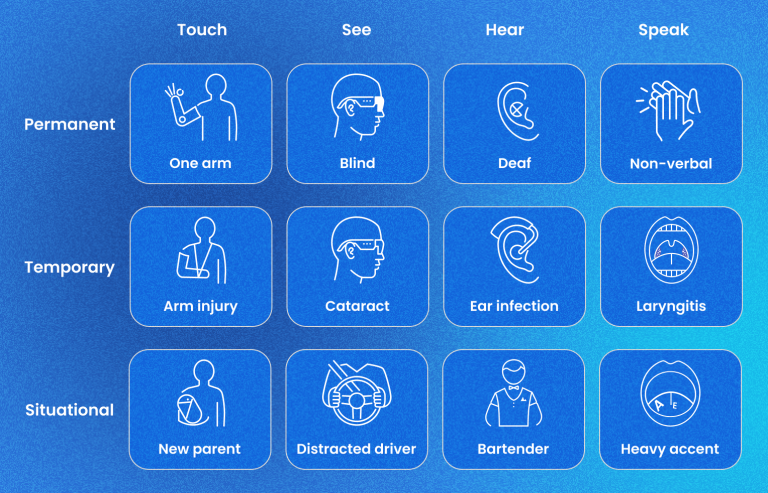Key points on this page:
- Having an inaccessible website doesn’t just cause hurdles to your current clients, it can create an entry barrier for potential new customers.
- An accessible website can lead to better search engine rankings.
- In Australia, all government websites must meet WCAG 2.0 Level AA standard.
Summary
Accessibility is quickly becoming less of a “nice to have” and more of a “must have”, especially as global legislation makes it a legal requirement.
Having an accessible website improves the user experience and reduces obstacles for all users, including those with disabilities.
Accessibility is a key part of any digital strategy, and without it, your website will lag behind – and your business will feel the financial impacts, too.
What makes an accessible website so important for business?
When posing accessibility issues with a client’s website, we often get this response: “That’s okay. We don’t have any current clients with disabilities.”
This type of thinking indicates a deeper problem with the way we perceive accessibility: as an issue that only rears its head when a person with a disability raises their voice.
Yet 93% of disabled website users won’t report inaccessible websites to their owners.

Having an inaccessible website doesn’t just cause hurdles to your current clients, who may be experiencing temporary, situational or permanent disabilities (such as using a mobile device while their dominant hand is injured). It also creates an entry barrier for potential new customers.
16% of the world’s global population experiences a significant disability, according to the World Health Organisation. In Australia, that number is 1 in 6, or 18% of the population.
Can your business afford to lose 18% of its potential customer base?
The business case for accessibility
Saving costs
There’s a certain legal risk that’s attached to digital accessibility. Many countries have legislation around building to WCAG 2.1 standards. In Australia, all government websites must meet WCAG 2.0 Level AA standard.
While the legal risk for private organisations is somewhat low, legislation is being introduced over time that is gradually pushing for accessibility as a digital requirement for all.
There are even tax benefits if you live in Australia. Up until the end of the 2022/2023 financial year, a small business entity is able to use the instant asset write-off and claim the cost of the website in full.
After this financial year, it will have to be depreciated (likely over 5 years). Make sure to always check with your accountant before making any decisions related to tax.
Extend your market reach
An accessible website aligns closely with good user experience. Your users aren’t all the same – they also aren’t all experiencing your website from the same well-lit room on a good-quality PC.
Making your website accessible means ensuring that regardless of disability, regardless of internet connection, and regardless of device, the site is still usable.

Image shows examples of permanent (one arm, blind, deaf, non-verbal), temporary (arm injury, cataract, ear infection, laryngitis), and situational (new parent, distracted driver, bartender, heavy accent) disabilities.
If you care about growing your customer base, you should already care about your website’s user experience (or UX). An experience that is seamless and without difficulty is one that drives users to convert and increases user satisfaction.
And it’s been proven to work.
On average, e-commerce websites that redesign for better usability double their sales.
Upon upgrading their website with an accessibility focus, UK supermarket Tesco saw website revenue increase from £52 million GBP in 2000 to £235 million.
A new website that puts your users first could be the new step to increasing sales for your business.
Boost your website SEO
The crossovers between SEO and accessibility are extensive, and this is largely because Google puts user experience at the heart of its strategy. An accessible website is a usable one, and this can lead to better search engine rankings.
In 2011, American public radio show This American Life (TAL) committed to creating accessible transcripts for their entire archive of recorded programs, which go back to 1995. As a result, search traffic increased 6.86%. They also found that 7.23% of visitors viewed at least one transcript.
Many different factors that are important for SEO are also important for accessibility, including alternative image text, page loading time, page titles, and headings.
Google’s Lighthouse tool is a great place to start when evaluating where your website can improve in these areas – though we don’t recommend it as a single source of truth.
Plus, Google loves quality, meaningful content, and that’s a key factor of any accessible website too.
Though it may not be an “official” ranking factor, making your website accessible is likely to have a positive impact on your search engine rankings.
Don’t wait to start your digital accessibility journey
While we recommend starting with a website that considers accessibility as much as possible, it’s also important to note that accessibility is an ongoing project, much like all parts of business.
Like other business processes, you can’t simply set and forget: your website will require ongoing monitoring and adjustment.
On a similar note, accessibility isn’t about perfection – it’s about making continuous improvements, so don’t let it seem like an intimidating, impossible feat.
Make sure your website can keep up with your business. At Dux, all of our websites are built with accessibility in mind, and the option to achieve AA or even AAA compliance if required.
Get in touch with us here to find out how we can help you.